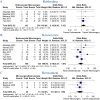Endovascular or microsurgical? Defining the best approach for blood blister aneurysms: A comparative meta-analysis
- PMID: 40509749
- PMCID: PMC12165959
- DOI: 10.1177/19714009251346467
Endovascular or microsurgical? Defining the best approach for blood blister aneurysms: A comparative meta-analysis
Abstract
IntroductionBlood blister-like aneurysms (BBLAs) are rare, typically found in the anteromedial supraclinoid segment of the internal carotid artery, and are related to high morbidity and mortality rates. Although microsurgery has been traditionally used to manage BBLAs, the Endovascular treatment (EVT) is gaining importance. We aim to compare these two methods using a systematic review and meta-analysis.MethodsA systematic search of PubMed, Embase, and Web of Science databases following PRISMA guidelines was conducted. We pooled odds ratios (OR) with 95% confidence intervals using a random-effects model, and I2 to assess heterogeneity. Eligible studies compared microsurgery and EVT for BBLAs. Outcome measures included Good and Poor clinical outcomes by Modified Rankin Scale (mRS), Epilepsy, Infection, Intracranial Hemorrhage, Vasospasm, Ischemic Events, Mortality, Operative Rupture, Rebleeding, Recurrence, and Retreatment.ResultsFifteen studies with 770 patients were included (401 microsurgery; 369 EVT). EVT appeared to be protective against Poor Clinical Outcomes (mRS >2), with an OR of 0.43 (95% CI 0.21 to 0.87), and Ischemic Events, having an OR of 0.33 (95% CI 0.18 to 0.61). Microsurgery was related to higher Mortality, with an OR of 2.72 (95% CI 1.46 to 5.06), and Operative Rupture, with 7.72 (95% CI 3.50 to 17.07). EVT also statistically favored the Good Clinical Outcomes analysis, with an OR of 3.13 (95% CI 1.40 to 6.98). Epilepsy, Infection, Intracranial Hemorrhage, and Vasospasm occurrence showed no significant statistical difference.ConclusionDespite microsurgery being traditionally used in BBLAs management, EVT has been shown to be a safer and lower-morbidity option.
Keywords: Aneurysm; blister; endovascular; hemorrhage; microsurgery.
Conflict of interest statement
The author(s) declared no potential conflicts of interest with respect to the research, authorship, and/or publication of this article.
The author(s) received no financial support for the research, authorship, and/or publication of this article.
Figures






References
-
- Ogawa A, Suzuki M, Ogasawara K. Aneurysms at nonbranching sites in the surpaclinoid portion of the internal carotid artery: internal carotid artery trunk aneurysms. Neurosurgery 2000; 47(3): 578–586. - PubMed
-
- Gonzalez AM, Narata AP, Yilmaz H, et al. Blood blister-like aneurysms: single center experience and systematic literature review. Eur J Radiol 2014; 83(1): 197–205. - PubMed
-
- Pathological consideration of a “blister-like” aneurysm at the superior wall of the internal carotid artery: case report. Neurosurgery. 1997. Available from: https://journals.lww.com/00006123-199702000-00038 - PubMed
-
- Kazumata K, Nakayama N, Nakamura T, et al. Changing treatment strategy from clipping to radial artery graft bypass and parent artery sacrifice in patients with ruptured blister-like internal carotid artery aneurysms. Neurosurgery 2014; 10(1): 66–73. - PubMed
-
- Barrow DL, Pradilla G, McCracken DJ. Intracranial blister aneurysms: clip reconstruction techniques. FOC 2015; 39(videosuppl1): V20. - PubMed
Publication types
LinkOut - more resources
Full Text Sources

